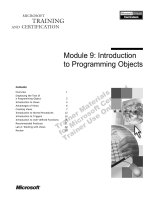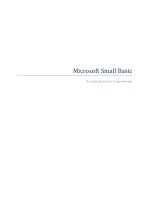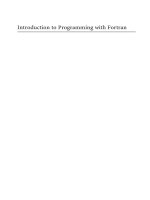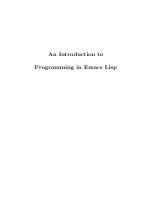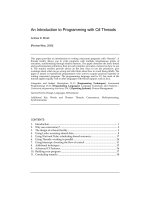Session 08 Introduction to Programming
Bạn đang xem bản rút gọn của tài liệu. Xem và tải ngay bản đầy đủ của tài liệu tại đây (225.6 KB, 27 trang )
LBC, Session 8
Pointer
FPT APTECH COMPUTER EDUCATION HANOI
Objectives
• Explain what a pointer is and where it is used
• Explain how to use pointer variables and pointer
operators
• Assign values to pointers
• Explain pointer arithmetic
• Explain pointer comparisons
• Explain pointers and single dimensional arrays
• Explain Pointer and multidimensional arrays
• Explain how allocation of memory takes place
LBC/Session 8
2
What is a Pointer?
• A pointer is a variable, which contains the address of a
memory location of another variable
• If one variable contains the address of another variable, the
first variable is said to point to the second variable
• A pointer provides an indirect method of accessing the value
of a data item
• Pointers can point to variables of other fundamental data
types like int, char, or double or data aggregates like arrays or
structures
LBC/Session 8
3
What are Pointers used for?
• Some situations where pointers can be used are:
– To return more than one value from a function
– To pass arrays and strings more conveniently from one function
to another
– To manipulate arrays easily by moving pointers to them
instead of moving the arrays itself
– To allocate memory and access it
(Direct Memory Allocation)
LBC/Session 8
4
Pointer Variables
• A pointer declaration consists of a base type and
a variable name preceded by an *
• General declaration syntax is :
type *name;
• For Example:
int *var2;
LBC/Session 8
5
Pointer Operators
• There are 2 special operators which are used
with pointers :& and *
• & operator is a unary operator and it returns the
memory address of the operand
p_var = &var;
• Operator * is the complement of &, returns the value
contained in the memory location pointed to by the
pointer variable’s value
value = *p_var
LBC/Session 8
6
Assigning Values To Pointers-1
• Values can be assigned to pointers through the &
operator.
p_var = &var;
Here the address of var is stored in the variable p_var
• It is also possible to assign values to pointers through
another pointer variable pointing to a data item of the
same data type
p_var = &var;
p_var1 = p_var;
LBC/Session 8
7
Assigning Values To Pointers-2
• Variables can be assigned values through their
pointers as well
*p_var = 10;
• The above declaration will assign 10 to the
variable var if p_var points to var
LBC/Session 8
8
Pointer Arithmetic-1
Addition and subtraction are the only operations that can be
performed on pointers
int var, *p_var;
p_var = &var;
var =500;
p_var++;
Let us assume that var is stored at the address 1000
Then ptr_var has the value 1000 stored in it. Since integers
are 2 bytes long, after the expression “ptr_var++;” ptr_var
will have the value as 1002 and not 1001
LBC/Session 8
9
Pointer Arithmetic-2
• Each time a pointer is incremented, it points to the memory
++ptr_var
or
points to next integer after var
location
of the next element of its base type
ptr_var++
•—ptr_var
Each timeor
it is decremented
it points
to the previous
location of
points
to integer
to the
var
previous element
ptr_var—
•ptr_var
All other +1
pointers will increase
or to
decrease
depending
points
the ith integer
after on
var
the length
they are
pointing
to
ptr_var
-1of the data typepoints
to the
ith integer
before var
++*ptr_var or
will increment var by 1
(*ptr_var)++
*ptr_var++
will fetch the value of the next
integer after var
LBC/Session 8
10
Pointer Comparisons
Returns true provided a is stored before b
Returns true provided a is stored after b
Returns
true provided
stored before b or
can
be compared
inaaisrelational
ptr_a and ptr_b point to the same
locationboth the pointers are pointing to
expression provided
ptr_a >= ptr_b
Returns true provided a is stored after b or
variables of theptr_a
same
type
and
ptr_b point to the same
location.
• Consider
ptr_a
= ptr_b
that ptr_a
and
ptr_b
areboth
2 pointer
Returns
true
provided
pointersvariables,
ptr_a and
ptr_b points to the same data
which point to data
elements a and b. In this case the
element.
ptr_a != ptr_b
Returns true provided both pointers ptr_a and
following comparisons
are
possible:
ptr_b point
to different
data
elements but of the same type.
ptr_a = NULL
Returns true if ptr_ais assigned NULL value
(zero)
ptr_a < ptr_b
ptr_a > ptr_b
ptr_a
ptr_b
• Two<=
pointers
LBC/Session 8
11
Pointers and Single Dimensional
Arrays-1
The address of an array element can be expressed
in two ways :
– By writing the actual array element preceded by the
ampersand sign (&)
– By writing an expression in which the subscript is
added to the array name
LBC/Session 8
12
Pointers and Single Dimensional
Arrays-2
void main()
{
int ary[10]
= {1, 2, 3, 4, 5, 6, 7, 8, 9, 10};
int i;
for (i = 0; i < 10; i ++)
{
printf(“\ni=%d,aryi]=%d,*(ary+i)=%d“,
i,ary[i],*(ary + i));
printf(“&ary[i]=%X,ary+i=%X”,
&ary[i],ary+i);
}
}
LBC/Session 8
13
Pointers and Single Dimensional
Arrays-3
i=0 ary[i]=l
*(ary+i)=1
&ary[i]=194
ary+i
= 194
i=l
i=2
i=3
i=4
ary[i]=2
ary[i]=3
ary[i]=4
ary[i]=5
*(ary+i)=2
*(ary+i)=3
*(ary+i)=4
*(ary+i)=5
&ary[i]=196
&ary[i]=198
&ary[i]=19A
&ary[i]=19C
ary+i
ary+i
ary+i
ary+i
=
=
=
=
i=5 ary[i]=6
*(ary+i)=6
&ary[i]=19E
ary+i
= 19E
i=6 ary[i]=7
*(ary+i)=7
&ary[i]=lAO
ary+i
= 1A0
i=7 ary[i]=8
i=8 ary[i]=9
*(ary+i)=8
*(ary+i)=9
&ary[i]=lA2
&ary[i]=lA4
ary+i
ary+i
= 1A2
= 1A4
i=9 ary[i]=10
*(ary+i)=10 &ary[i]=lA6
ary+i
= 1A6
LBC/Session 8
196
198
19A
19C
14
Pointers and Multi Dimensional
Arrays-1
• A two-dimensional array can be defined as a
pointer to a group of contiguous one
dimensional arrays
• A two-dimensional array declaration can be
written as :
data_type (*ptr_var) [expr 2];
instead of
data_type ptr_var [expr1] [expr 2];
LBC/Session 8
15
Pointers and Strings-1
void main()
{
char a, str[81], *ptr;
printf(“\nEnter a sentence:”);
gets(str);
printf(“\nEnter character to search for:”);
a = getche();
ptr = strchr(str,a);
/* return pointer to char*/
printf( “\nString starts at address: %u”,str);
printf(“\nFirst occurrence of the character is
at address: %u ”,ptr);
printf(“\n Position of first occurrence
(starting from 0)is: % d”, ptr-str);
LBC/Session 8
}
16
Pointers and Strings-2
Enter a sentence: We all live in a yellow submarine
Enter character to search for: Y
String starts at address: 65420.
First occurrence of the character is at address:
65437.
Position of first occurrence (starting from 0) is:
17
LBC/Session 8
17
Allocating Memory-1
The malloc() function is one of the most
commonly used functions which permit allocation
of memory from the pool of free memory. The
parameter for malloc() is an integer that specifies
the number of bytes needed.
LBC/Session 8
18
Allocating Memory-2
Example
LBC/Session 8
19
free()-1
free() function can be used to de-allocates (frees) memory
when it is no longer needed.
Syntax:
void free(
void *ptr );
•This function deallocates the space pointed to by ptr,
•freeing it up for future use.
• ptr must have been used in a previous call to malloc(),
• calloc(), or realloc().
LBC/Session 8
20
free()-2
#include <stdlib.h>
void main(){
int number, *ptr, i;
printf("How many ints would you like store? ");
scanf("%d", &number);
ptr = (int *) malloc (number*sizeof(int));
if(ptr!=NULL)
{
for(i=0 ; i
*(ptr+i) = i;
}
for(i=number ; i>0 ; i--)
{
printf("%d\n",*(ptr+(i-1)));
}
free(ptr); /* free allocated memory */
return 0;
}
LBC/Session 8
}
21
calloc()-1
• calloc is similar to malloc, but the main difference is
that the
• values stored in the allocated memory space is zero
by default
calloc requires two arguments
The first is the number of variables you'd like to
allocate memory for The second is the size of each
variable
Syntax :
void *calloc( size_t num, size_t size );
LBC/Session 8
22
calloc()-2
void main()
{
float *calloc1, *calloc2;
int i;
calloc1 = (float *) calloc(3, sizeof(float));
calloc2 = (float *)calloc(3, sizeof(float));
if(calloc1!=NULL && calloc2!=NULL)
{
for(i=0 ; i<3 ; i++)
{
printf("calloc1[%d] holds %05.5f ",
i, calloc1[i]);
printf("\ncalloc2[%d] holds %05.5f ",
i, *(calloc2+i));
}
free(calloc1);
free(calloc2);
LBC/Session 8
Contd……
}
23
realloc()-1
You've allocated a certain number of bytes for an array but later
find that you want to add values to it.You could copy everything
into a larger array, which is inefficient, or you can allocate more
bytes using realloc, without losing your data.
realloc takes two arguments
The first is the pointer referencing the memory
The second is the total number of bytes you want to reallocate
Syntax:
void *realloc( void *ptr, size_t size );
LBC/Session 8
24
realloc()-2
int *ptr, i;
ptr = (int *)calloc(5, sizeof(int *));
if(ptr!=NULL)
{
*ptr = 1; *(ptr+1) = 2;
ptr[2] = 4; ptr[3] = 8; ptr[4] = 16;
ptr = (int *)realloc(ptr, 7*sizeof(int));
if(ptr!=NULL)
{
ptr[5] = 32; /* now it's legal! */
for(i=0 ; i<7 ; i++)
{
printf("ptr[%d] holds %d\n", i, ptr[i]);
}
realloc(ptr,0);
return 0;
}
LBC/Session 8
25
